We’re back with Susan Warde in St. Paul, Minnesota! Yesterday we looked back at the year in her front garden, and today we’re taking the same tour through the seasons but in her back garden, where things are a bit shadier but no less beautiful.
 May 17: The back garden is shadier than the front, and the colors are subtler, but the unfurling fronds of maidenhair fern (Adiantum pedatum, Zones 3–8) in the foreground and royal fern (Osmunda regalis, Zones 3–9) in the top right give a pop of color to the spring garden. White trillium (Trillium grandiflorum, Zones 3–8) and white-edged hostas light up the background.
May 17: The back garden is shadier than the front, and the colors are subtler, but the unfurling fronds of maidenhair fern (Adiantum pedatum, Zones 3–8) in the foreground and royal fern (Osmunda regalis, Zones 3–9) in the top right give a pop of color to the spring garden. White trillium (Trillium grandiflorum, Zones 3–8) and white-edged hostas light up the background.
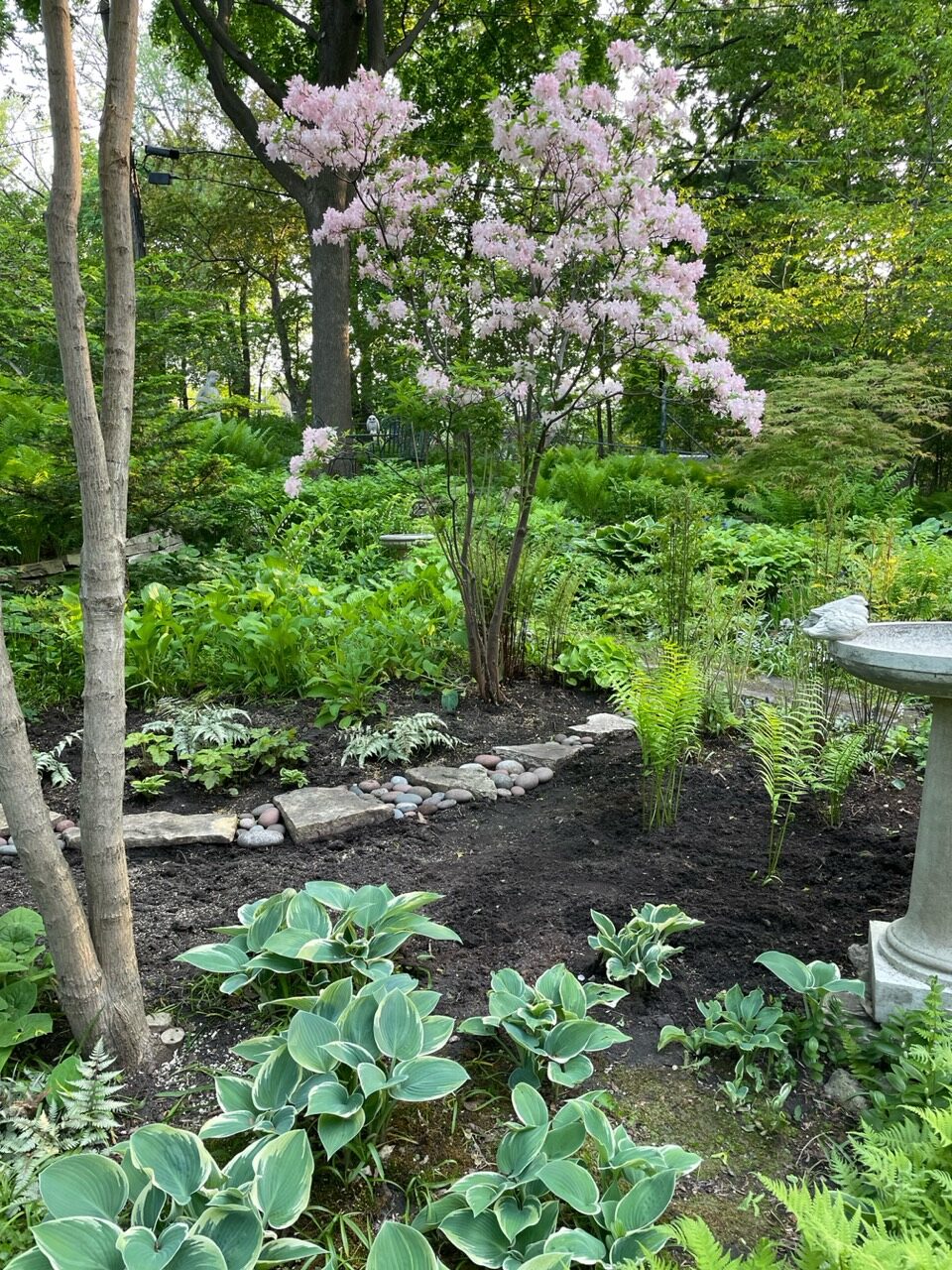 May 23: Though this tall Northern Lights azalea’s cultivar name is ‘White Lights’ (Rhododendron ‘White Lights’, Zones 4–8), it is actually pink unless grown in full sun. Bare ground is exposed where I dug out quantities of gooseneck loosestrife (Lysimachia clethroides, Zones 3–8). Tiny shoots kept coming back all summer. I don’t recommend it!
May 23: Though this tall Northern Lights azalea’s cultivar name is ‘White Lights’ (Rhododendron ‘White Lights’, Zones 4–8), it is actually pink unless grown in full sun. Bare ground is exposed where I dug out quantities of gooseneck loosestrife (Lysimachia clethroides, Zones 3–8). Tiny shoots kept coming back all summer. I don’t recommend it!
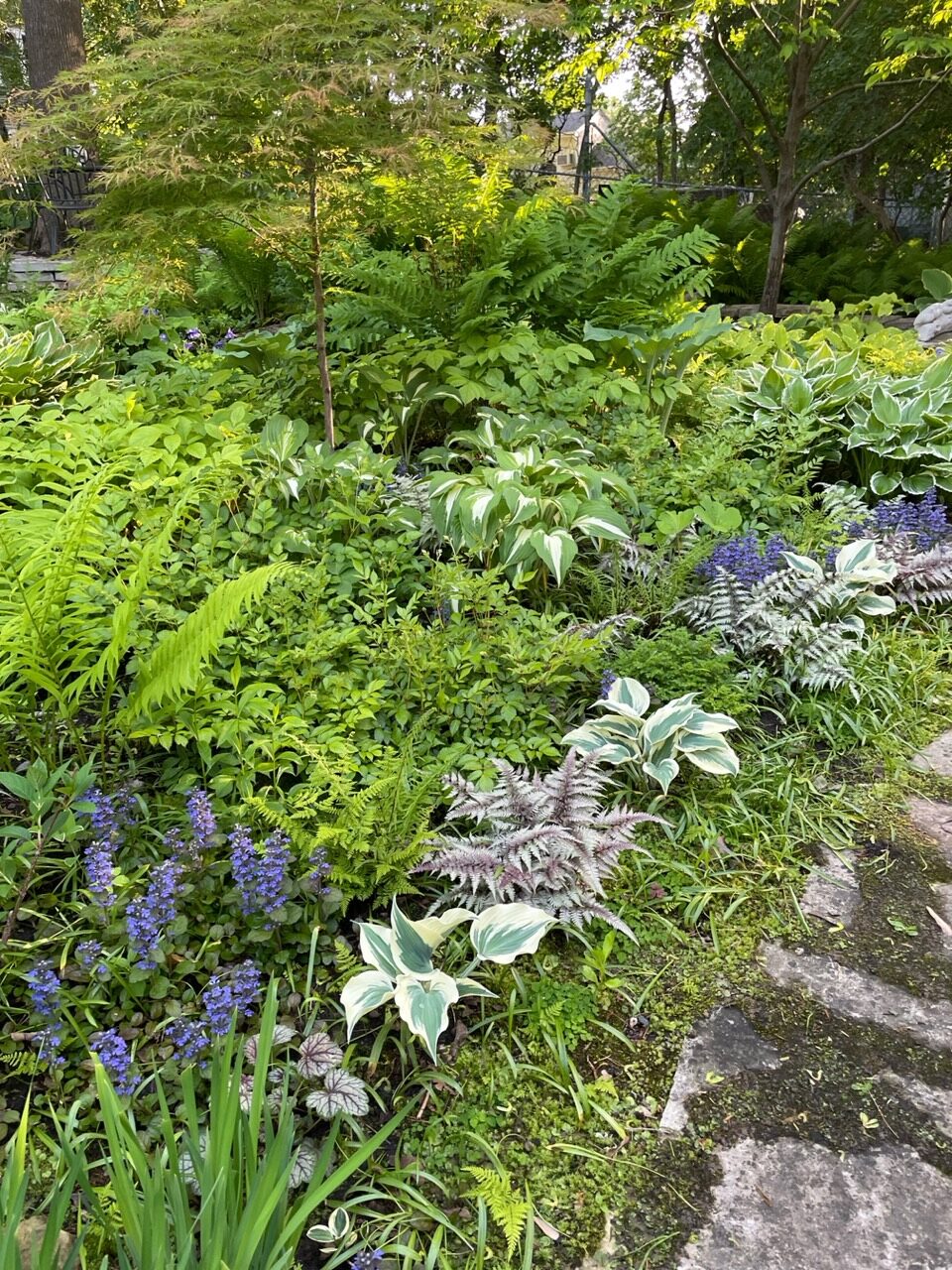 May 27: This area is surrounded by a flagstone path. The small maple (upper left) is Acer × pseudoseiboldianum ‘Ice Dragon’ (Zones 4–8). Hostas (the white-edged ones are ‘Blue Ivory’, Zones 3–8), ferns, bugleweed (Ajuga reptens, Zones 3–10), and astilbes (Astilbe sp., Zones 4–8) crowd around it.
May 27: This area is surrounded by a flagstone path. The small maple (upper left) is Acer × pseudoseiboldianum ‘Ice Dragon’ (Zones 4–8). Hostas (the white-edged ones are ‘Blue Ivory’, Zones 3–8), ferns, bugleweed (Ajuga reptens, Zones 3–10), and astilbes (Astilbe sp., Zones 4–8) crowd around it.
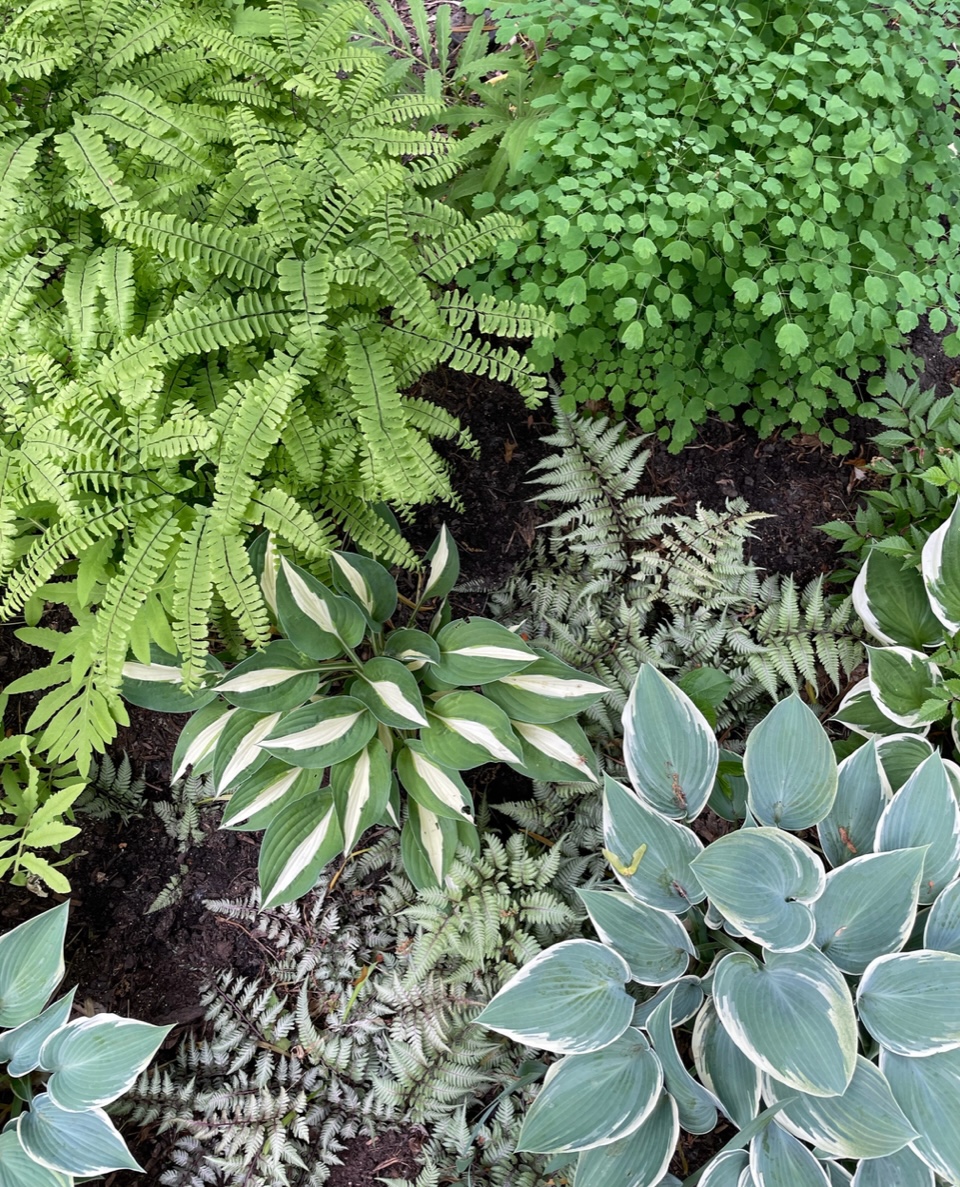 June 5: The back garden is mostly about foliage. Here Japanese painted ferns (Athyrium japonicum, Zones 5–9) maidenhair fern, sensitive fern (Onoclea sensibilis, Zones 4–8), meadow rue (Thalictrum dioicum, Zones 4–7), and three different hostas contrast nicely in a narrow garden along the garage.
June 5: The back garden is mostly about foliage. Here Japanese painted ferns (Athyrium japonicum, Zones 5–9) maidenhair fern, sensitive fern (Onoclea sensibilis, Zones 4–8), meadow rue (Thalictrum dioicum, Zones 4–7), and three different hostas contrast nicely in a narrow garden along the garage.
 June 7: Purple Siberian iris (Iris siberica, Zones 3–8) are in bloom by early June. Behind them is a large clump of narrow-leaved spleenwort (Diplasium pycnocarpon, Zones 3–8).
June 7: Purple Siberian iris (Iris siberica, Zones 3–8) are in bloom by early June. Behind them is a large clump of narrow-leaved spleenwort (Diplasium pycnocarpon, Zones 3–8).
 June 19: At this point I’d begun replanting the space (photo 2) by now more or less free of gooseneck loosestrife. This area of the back garden includes Japanese painted fern and beech fern (Phegopteris connectilis, Zones 2–5) on either side of the ‘El Niño’ hostas. The ground cover on the left is Sedum ‘John Creech’ (Zones 3–8), and there are a couple of patches of wild ginger (Asarum canadense, Zones 4–6). The azalea has leafed out; it will turn orange in September.
June 19: At this point I’d begun replanting the space (photo 2) by now more or less free of gooseneck loosestrife. This area of the back garden includes Japanese painted fern and beech fern (Phegopteris connectilis, Zones 2–5) on either side of the ‘El Niño’ hostas. The ground cover on the left is Sedum ‘John Creech’ (Zones 3–8), and there are a couple of patches of wild ginger (Asarum canadense, Zones 4–6). The azalea has leafed out; it will turn orange in September.
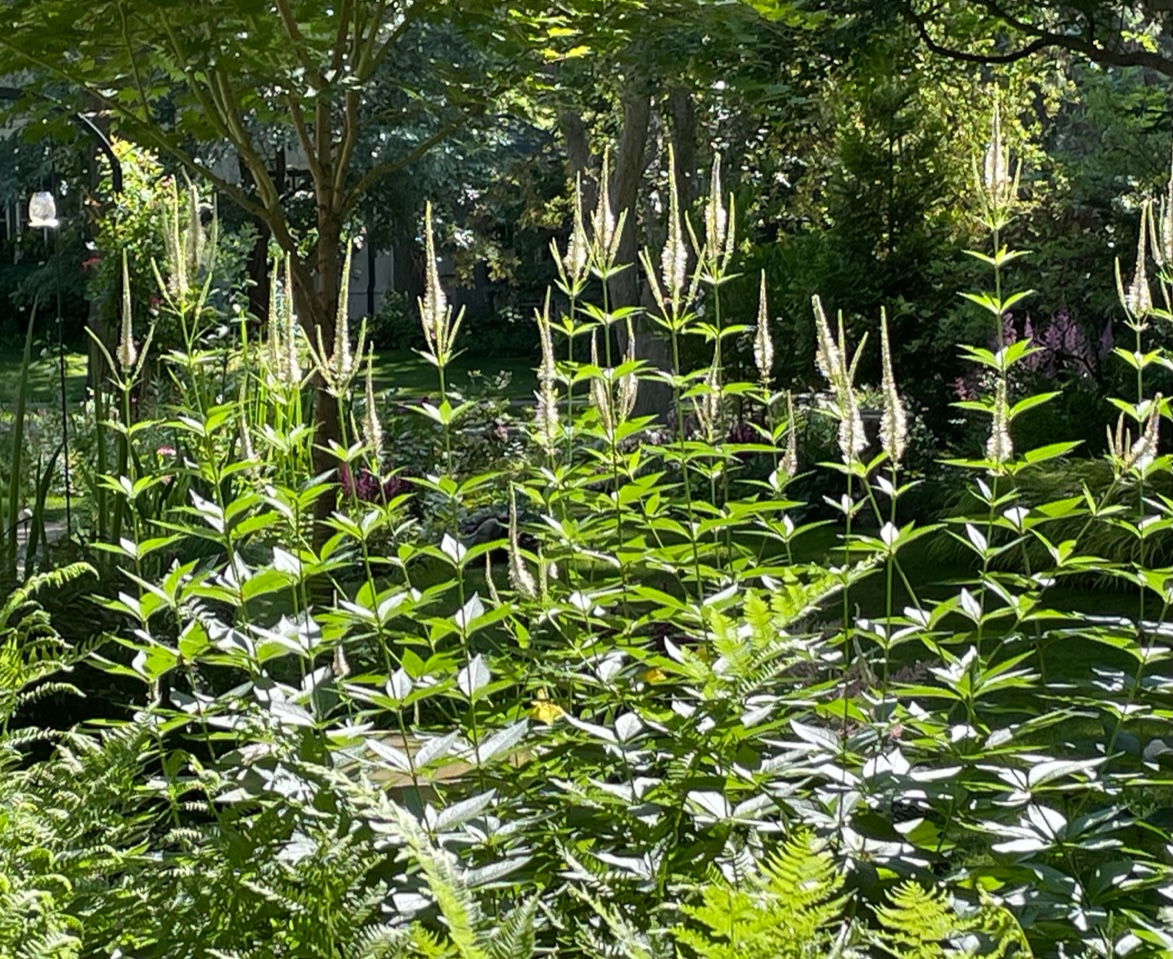 July 11: The back garden features pinks and purples in spring. By midsummer most of the blooms are white or lavender. These white spikes, very attractive to pollinators, belong to Culver’s root (Veronicastrum virginicum, Zones 4–8).
July 11: The back garden features pinks and purples in spring. By midsummer most of the blooms are white or lavender. These white spikes, very attractive to pollinators, belong to Culver’s root (Veronicastrum virginicum, Zones 4–8).
 August 8: A lot of hostas and many species of ferns fill in the late summer garden.
August 8: A lot of hostas and many species of ferns fill in the late summer garden.
 October 25: It’s all over except for the cleaning up, but a new-this-season clematis is putting out a few last blossoms. On the left is a Korean maple (Acer pseudosieboldianum, Zones 4–8), also reflected in the mirror.
October 25: It’s all over except for the cleaning up, but a new-this-season clematis is putting out a few last blossoms. On the left is a Korean maple (Acer pseudosieboldianum, Zones 4–8), also reflected in the mirror.
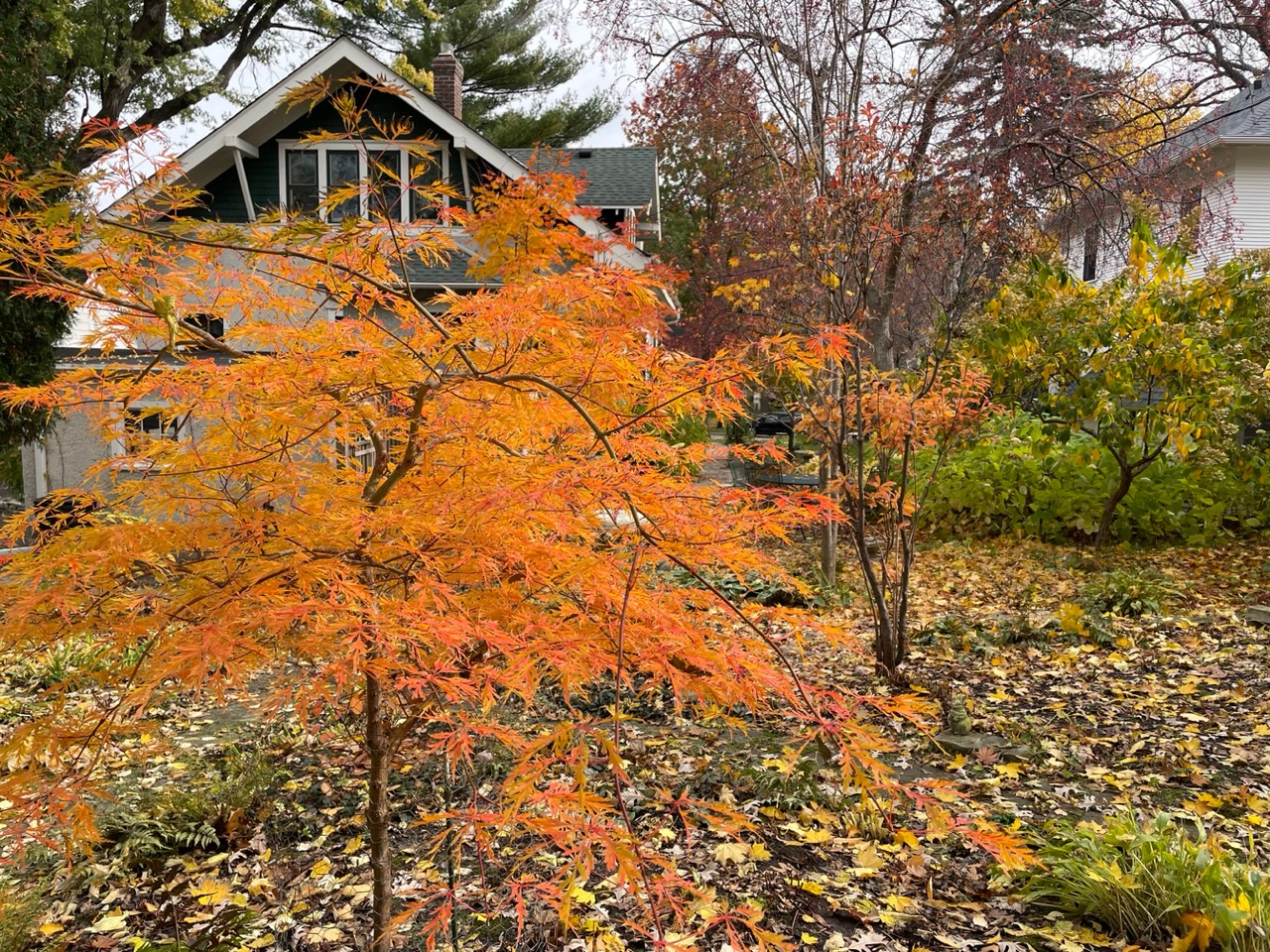 October 28: The back of the garden is lit up by the flame leaves of the ‘Ice Dragon’ maple shown in the third photo. It’s a hardy hybrid between a Japanese maple and a Korean maple.
October 28: The back of the garden is lit up by the flame leaves of the ‘Ice Dragon’ maple shown in the third photo. It’s a hardy hybrid between a Japanese maple and a Korean maple.
Have a garden you’d like to share?
Have photos to share? We’d love to see your garden, a particular collection of plants you love, or a wonderful garden you had the chance to visit!
To submit, send 5-10 photos to [email protected] along with some information about the plants in the pictures and where you took the photos. We’d love to hear where you are located, how long you’ve been gardening, successes you are proud of, failures you learned from, hopes for the future, favorite plants, or funny stories from your garden.
Have a mobile phone? Tag your photos on Facebook, Instagram or Twitter with #FineGardening!
Do you receive the GPOD by email yet? Sign up here.
